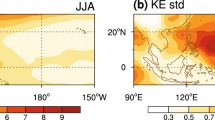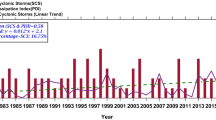Abstract
This study examines the variability of the power dissipation index (PDI) for different regions of the East Asia region during the period 1960–2013. The annual PDI (APDI) in the region is calculated as the sum of the PDI, defined as the cube of the maximum sustained wind speed at landfall of each tropical cyclone (TC) making landfall at that region. Upward and downward trends in APDI are found in the northern and southern parts of East Asia respectively, suggesting a possible northward shift in TC landfall locations. Interdecadal variations of the APDI can also be found in some regions. The APDI in various regions show a close relation with the PDI distribution over the western North Pacific (WNP) with three characteristic patterns. The ENSO and basin-wide mode represents the PDI patterns associated with ENSO events and the overall PDI over the WNP. The east–west dipole mode and the north–south dipole mode denote the east–west and north–south shifts of PDI respectively. Based on the steering flow (average winds within the 850–300 hPa layer) near the East Asian coast, a three-cell model for TC landfall in East Asia is proposed, which corresponds to three major modes of the atmospheric circulation in the WNP. Each of these modes shows an anomalous circulation located east of Taiwan, east of Japan and the South China Sea, respectively and each of which has a significant impact on the APDI in some regions along the coast of East Asia. A northward shift in the APDI along the East Asian coast is identified in the period 1997–2013 as a result of the change in steering flow pattern, northward shift in TC genesis location and weaker vertical wind shear over the ocean near the coastal areas.
















Similar content being viewed by others
References
Chan JCL (2008) Decadal variations of intense typhoon occurrence in the western North Pacific. Proc R Soc A 464:249–272
Chan JCL, Gray WM (1982) Tropical cyclone movement and surrounding flow relationships. Mon Weather Rev 110:1354–1374
Chan JCL, Xu M (2009) Inter-annual and inter-decadal variations of landfalling tropical cyclones in East Asia. Part I: time series analysis. Int J Climatol 29:1285–1293. doi:10.1002/joc.1782
Choi KS, Kim BJ, Kim DW, Byun HR (2010a) Interdecadal variation of tropical cyclone making landfall over the Korean Peninsula. Int J Climatol 30(10):1472–1483. doi:10.1002/joc.1986
Choi KS, Wu CC, Cha EJ (2010b) Change of tropical cyclone activity by Pacific-Japan teleconnection pattern in the western North Pacific. J Geophys Res 115:D19114
Choi Y, Ha KJ, Ho CH, Chung CE (2015) Interdecadal change in typhoon genesis condition over the western North Pacific. Clim Dyn. doi:10.1007/s00382-015-2536-y
Emanuel K (2005) Increasing destructiveness of tropical cyclones over the past 30 years. Nature 436:686–688
Goh AZC, Chan JCL (2012) Variations and prediction of the annual number of tropical cyclone affecting Korea and Japan. Int J Climatol 32:178–189
Grossman MJ, Zaiki M, Nagata R (2014) Interannual and interdecadal variations in typhoon tracks around Japan. Int J Climatol. doi:10.1002/joc.4156
Hannachi A, Joliffe I, Stephenson D (2007) Empirical orthogonal functions and related techniques in atmospheric science: a review. Int J Climatol 27:1119–1152. doi:10.1002/joc.1499
Kim JH, Ho CH, Sui CH (2005) Circulation features associated with the record-breaking typhoon landfall on Japan in 2004. Geophys Res Lett 32:L14713. doi:10.1029/2005GL022494
Knutson TR, McBride JL, Chan J, Emanuel K, Holland G, Landsea C, Held I, Kossin JP, Srivastava AK, Sugi M (2010) Tropical cyclones and climate change. Nature Geosci 3:157–163. doi:10.1038/ngeo779
Kossin JP, Emanuel KA, Vecchi GA (2014) The poleward migration of the location of tropical cyclone maximum intensity. Nature 509:349–352
Kubota H, Chan JCL (2009) Interdecadal variability of tropical cyclone landfall in the Philippines from 1902 to 2005. Geophys Res Lett 36:L12802. doi:10.1029/2009GL038108
Li Q, Duan Y (2010) Tropical cyclone strikes at the coastal cities of China from 1949 to 2008. Meteorl Atmos Phys 107:1–7
Liu KS, Chan JCL (2003) Climatological characteristics and seasonal forecasting of tropical cyclones making landfall along the South China coast. Mon Weather Rev 131:1650–1662
Liu KS, Chan JCL (2008) Interdecadal variability of western North Pacific tropical cyclone tracks. J Clim 21:4464–4476
Liu KS, Chan JCL (2013) Inactive period of western North Pacific tropical cyclone activity in 1998–2011. J Clim 26:2614–2630
Lu X, Zhao B (2013) Analysis of the climatic characteristics of landing tropical cyclones in East China. J Trop Meteor 19(2):145–153
Mantua NJ, Hare SR, Zhang Y, Wallace JM, Francis RC (1997) A Pacific interdecadal climate oscillation with impacts on salmon production. Bull Am Meteor Soc 78:1069–1079
Nakazawa T, Rajendran K (2007) Relationship between tropospheric circulation over the western North Pacific and tropical cyclone approach/landfall on Japan. J Meteorol Soc Jpn 85:101–114
Park DSR, Ho CH, Kim JH, Kim HS (2011) Strong landfall typhoons in Korea and Japan in a recent decade. J Geophys Res 116:D07105. doi:10.1029/2010JD014801
Park DSR, Ho CH, Kim JH (2014) Growing threat of intense tropical cyclones to East Asia over the period 1977–2010. Environ Res Lett 9:014008. doi:10.1088/1748-9326/9/1/014008
Rodionov SN (2004) A sequential algorithm for testing climate regime shifts. Geophys Res Lett 31:L09204. doi:10.1029/2004GL019448
Simmons A, Uppala SM, Dee D, Kobayashi S (2007) ERA-Interim: new ECMWF reanalysis products from 1989 onwards. ECMWF Newsl 110:25–35
Southern RL (1979) The global socio-economic impact of tropical cyclones. Aust Meteorol Mag 26:175–195
Tu JY, Chou C, Chu PS (2009) The abrupt shift of typhoon activity in the vicinity of Taiwan and its association with western North Pacific-East Asian climate change. J Clim 22:3617–3628
Wakabayashi S, Kawamura R (2004) Extraction of major teleconnection patterns possibly associated with the anomalous summer climate in Japan. J Meteorol Soc Jpn 82:1577–1588. doi:10.2151/jmsj.82.1577
Wallace JM, Smith C, Bretherton CS (1992) Singular value decomposition of wintertime sea surface temperature and 500-mb height anomalies. J Clim 5:561–576
Weatherford C, Gray WM (1988) Typhoon structure as revealed by aircraft reconnaissance. Part II: structural variability. Mon Weather Rev 116:1044–1056
Wu L, Wang B, Braun SA (2008) Implications of tropical cyclone power dissipation index. Int J Climatol 28(6):727–731. doi:10.1002/joc.1573
Ying M, Zhang W, Yu H, Lu X, Feng J, Fan Y, Zhu Y, Chen D (2013) An overview of the China Meteorological Administration tropical cyclone database. J Atmos Ocean Technol 31:287–301. doi:10.1175/JTECH-D-12-00119.1
Yonekura E, Hall TM (2014) ENSO effect on East Asian tropical cyclone landfall via changes in tracks and genesis in a statistical model. J Appl Meteor Climatol 53:406–420. doi:10.1175/JAMC-D-12-0240.1
Zhang Q, Zhang W, Lu X, Chen YD (2011) Landfalling tropical cyclones activities in the south China: intensifying or weakening? Int J Climatol 32:1815–1924
Acknowledgments
The authors would like to thank the Taiwan Central Weather Bureau for providing the best-track data for tropical cyclones affecting Taiwan. This project is supported by the Research Grants Council General Research Fund CityU 100113.
Author information
Authors and Affiliations
Corresponding author
Rights and permissions
About this article
Cite this article
Liu, K.S., Chan, J.C.L. Variations in the power dissipation index in the East Asia region. Clim Dyn 48, 1963–1985 (2017). https://doi.org/10.1007/s00382-016-3185-5
Received:
Accepted:
Published:
Issue Date:
DOI: https://doi.org/10.1007/s00382-016-3185-5




